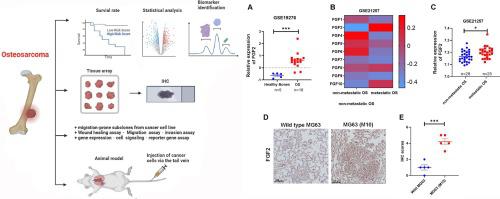当前位置:
X-MOL 学术
›
Biochem. Pharmacol.
›
论文详情
Our official English website, www.x-mol.net, welcomes your
feedback! (Note: you will need to create a separate account there.)
FGF2 drives osteosarcoma metastasis through activating FGFR1-4 receptor pathway-mediated ICAM-1 expression
BIOCHEMICAL PHARMACOLOGY ( IF 5.3 ) Pub Date : 2023-10-11 , DOI: 10.1016/j.bcp.2023.115853 Yu-Ching Huang , Wei-Cheng Chen , Chen-Lin Yu , Ting-Kuo Chang , Augusta I-Chin Wei , Tsung-Ming Chang , Ju-Fang Liu , Shih-Wei Wang
BIOCHEMICAL PHARMACOLOGY ( IF 5.3 ) Pub Date : 2023-10-11 , DOI: 10.1016/j.bcp.2023.115853 Yu-Ching Huang , Wei-Cheng Chen , Chen-Lin Yu , Ting-Kuo Chang , Augusta I-Chin Wei , Tsung-Ming Chang , Ju-Fang Liu , Shih-Wei Wang

|
Osteosarcoma is a malignant tumor with high metastatic potential, such that the overall 5-year survival rate of patients with metastatic osteosarcoma is only 20%. Therefore, it is necessary to unravel the mechanisms of osteosarcoma metastasis to identify predictors of metastasis by which to develop new therapies. Fibroblast growth factor 2 (FGF2) is a growth factor involved in embryonic development, cell migration, and proliferation. The overexpression of FGF2 and FGF receptors (FGFRs) has been shown to enhance cancer cell proliferation in lung, breast, gastric, and prostate cancers as well as melanoma. Nonetheless, the roles of FGF2 and FGFRs in human osteosarcoma cells remain unknown. In the present study, we found that FGF2 was overexpressed in human osteosarcoma sections and correlated with lung metastasis. Treatment of FGF2 induced migration activity, invasion activity, and intercellular adhesion molecule (ICAM)-1 expression in osteosarcoma cells. In particular, the downregulation or antagonism of FGFR1-4 suppressed FGF2-induced ICAM-1 expression and cancer cell migration. Furthermore, FGFR1, FGFR2, FGFR3, and FGFR4 were involved in FGF2-induced the phospholipase Cβ/protein kinase Cα/proto-oncogene c-Src signaling pathway and triggered c-Jun nuclear translocation. Subsequent c-Jun upregulation of activator protein-1 transcription activity on the ICAM-1 promoter led to an increased migration of osteosarcoma cells. Moreover, the knockdown of endogenous FGF2 suppressed ICAM-1 expression and migration of osteosarcoma cells. These findings suggest that FGF2/FGFR1-4 signaling promotes metastasis via its direct downstream target gene ICAM-1, revealing a novel potential therapeutic target for osteosarcoma.
中文翻译:

FGF2 通过激活 FGFR1-4 受体通路介导的 ICAM-1 表达驱动骨肉瘤转移
骨肉瘤是一种具有高转移潜力的恶性肿瘤,因此转移性骨肉瘤患者总体 5 年生存率仅为 20%。因此,有必要揭示骨肉瘤转移的机制,以确定转移的预测因子,从而开发新的疗法。成纤维细胞生长因子 2 (FGF2) 是一种参与胚胎发育、细胞迁移和增殖的生长因子。FGF2 和 FGF 受体 (FGFR) 的过表达已被证明可以增强肺癌、乳腺癌、胃癌和前列腺癌以及黑色素瘤中的癌细胞增殖。尽管如此,FGF2 和 FGFRs 在人骨肉瘤细胞中的作用仍然未知。在本研究中,我们发现 FGF2 在人骨肉瘤切片中过表达,并与肺转移相关。处理 FGF2 诱导骨肉瘤细胞中的迁移活性、侵袭活性和细胞间粘附分子 (ICAM)-1 表达。特别是,FGFR1-4 的下调或拮抗作用抑制了 FGF2 诱导的 ICAM-1 表达和癌细胞迁移。此外,FGFR1 、 FGFR2 、 FGFR3 和 FGFR4 参与 FGF2 诱导的磷脂酶 Cβ/蛋白激酶 Cα/原癌基因 c-Src 信号通路并触发 c-Jun 核转位。随后 ICAM-1 启动子上激活蛋白-1 转录活性的 c-Jun 上调导致骨肉瘤细胞迁移增加。此外,敲除内源性 FGF2 抑制了 ICAM-1 表达和骨肉瘤细胞的迁移。这些发现表明,FGF2/FGFR1-4 信号通过其直接下游靶基因 ICAM-1 促进转移,揭示了骨肉瘤的新潜在治疗靶点。
更新日期:2023-10-11
中文翻译:

FGF2 通过激活 FGFR1-4 受体通路介导的 ICAM-1 表达驱动骨肉瘤转移
骨肉瘤是一种具有高转移潜力的恶性肿瘤,因此转移性骨肉瘤患者总体 5 年生存率仅为 20%。因此,有必要揭示骨肉瘤转移的机制,以确定转移的预测因子,从而开发新的疗法。成纤维细胞生长因子 2 (FGF2) 是一种参与胚胎发育、细胞迁移和增殖的生长因子。FGF2 和 FGF 受体 (FGFR) 的过表达已被证明可以增强肺癌、乳腺癌、胃癌和前列腺癌以及黑色素瘤中的癌细胞增殖。尽管如此,FGF2 和 FGFRs 在人骨肉瘤细胞中的作用仍然未知。在本研究中,我们发现 FGF2 在人骨肉瘤切片中过表达,并与肺转移相关。处理 FGF2 诱导骨肉瘤细胞中的迁移活性、侵袭活性和细胞间粘附分子 (ICAM)-1 表达。特别是,FGFR1-4 的下调或拮抗作用抑制了 FGF2 诱导的 ICAM-1 表达和癌细胞迁移。此外,FGFR1 、 FGFR2 、 FGFR3 和 FGFR4 参与 FGF2 诱导的磷脂酶 Cβ/蛋白激酶 Cα/原癌基因 c-Src 信号通路并触发 c-Jun 核转位。随后 ICAM-1 启动子上激活蛋白-1 转录活性的 c-Jun 上调导致骨肉瘤细胞迁移增加。此外,敲除内源性 FGF2 抑制了 ICAM-1 表达和骨肉瘤细胞的迁移。这些发现表明,FGF2/FGFR1-4 信号通过其直接下游靶基因 ICAM-1 促进转移,揭示了骨肉瘤的新潜在治疗靶点。































 京公网安备 11010802027423号
京公网安备 11010802027423号